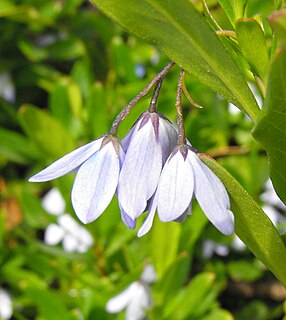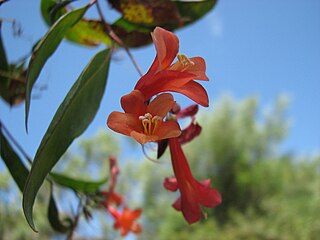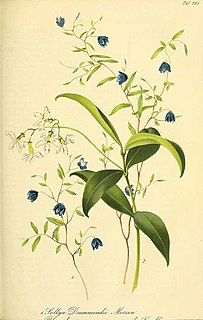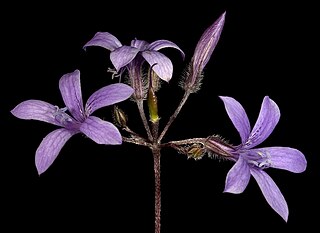
Pittosporaceae is a family of flowering plants that consists of 200–240 species of trees, shrubs, and lianas in 9 genera. Habitats range from tropical to temperate climates of the Afrotropical, Indomalayan, Oceanian, and Australasian realms. The type genus is Pittosporum Banks ex Gaertn.

Pittosporum is a genus of about 200 species of flowering plants in the family Pittosporaceae. The genus is probably Gondwanan in origin; its present range extends from Australasia, Oceania, Sicily, eastern Asia and some parts of Africa. Citriobatus can be included here, but might be a distinct genus. They are commonly known as pittosporums or, more ambiguously, cheesewoods.

Bursaria is a genus of large shrubs and small trees which are native to Australia. The genus was first described by Antonio Cavanilles in 1797, with his description of the type species B. spinosa. The name is derived from the Latin word bursa (purse) which relates to the shape of its seed capsules.

Billardiera is a genus of small vines and shrubs in the family, Pittosporaceae, which is endemic to Australia. The genus was first formally described in 1793 by botanist James Edward Smith who named it in honour of Jacques Labillardière, a French botanist.

Cheiranthera is a genus of ten species of flowering plants in the family Pittosporaceae and are all endemic to Australia. The following is a list of species accepted by the Australian Plant Census as at April 2020:

Rhytidosporum is a genus of flowering plants within the family Pittosporaceae. The type species is Rhytidosporum procumbens (Hook.) F.Muell.

Auranticarpa rhombifolia is a rainforest tree of eastern Australia. Known as the diamond leaf pittosporum, this tree is planted in many parts of Australia as an ornamental. The white flowers and orange fruit make it a most appealing street or garden tree. Other common names include hollywood, diamond leaf laurel, white myrtle and white holly.

Pittosporum multiflorum, known as the orange thorn, is a shrub growing in eastern Australia. The dense foliage provides a habitat for small birds and animals. It grows on shales or volcanic soils, from Eden, New South Wales north to Queensland, usually in or near rainforest areas.

Billardiera heterophylla is a species of flowering plant in the family Pittosporaceae, known by the common name bluebell creeper. It is native to Western Australia, but is grown as an ornamental plant in appropriate climates worldwide. It can sometimes be found growing in the wild as an introduced species or garden escapee, for example in other Australian states and in California, where it is popular in landscaping. It is sometimes considered a weed.

Marianthus is a genus of flowering plants within the family Pittosporaceae.

Pittosporum angustifolium is a shrub or small tree growing throughout inland Australia. A slow growing plant, usually seen between two and six metres high, though exceptional specimens may exceed ten metres. Common names include weeping pittosporum, butterbush, cattle bush, native apricot, apricot tree, gumbi gumbi, cumby cumby, meemeei, poison berry bush, and berrigan. It is drought and frost resistant. It can survive in areas with rainfall as low as 150 mm per year. A resilient desert species, individuals may live for over a hundred years. A revision of the genus Pittosporum in 2000 re-instated this species.

Pittosporum phillyreoides, with the common names weeping pittosporum and willow pittosporum, is a shrub or small columnar tree in the Apiales order, endemic to Australia.

Billardiera fraseri is a species of plant in the family, Pittosporaceae, which is endemic to Western Australia.

Billardiera fusiformis is a species of plant in the family, Pittosporaceae, which is endemic to Western Australia.

Billardiera drummondii is a slender climber in the Pittosporaceae family, native to the south-west of Western Australia, which grows in Eucalypt woodland on coastal soils. Its flowers are blue to purple and seen in January.

Marianthus candidus, commonly known as white marianthus, is a shrub of the pittosporum family, Pittosporaceae native to southwest Western Australia.

Marianthus tenuis is a shrub of the pittosporum family, Pittosporaceae native to southwest Western Australia.

Marianthus drummondianus is a shrub of the pittosporum family, Pittosporaceae native to southwest Western Australia.
Lindy Webster Cayzer is an Australian botanist.
Rhytidosporum inconspicuum is an inconspicuous, rhizomatous shrub in the pittosporum family, Pittosporaceae. The species is found in New South Wales, Victoria and Tasmania.


















